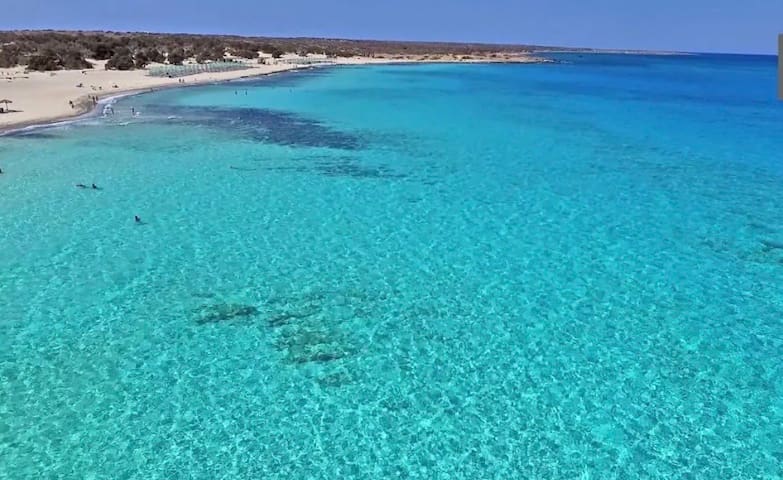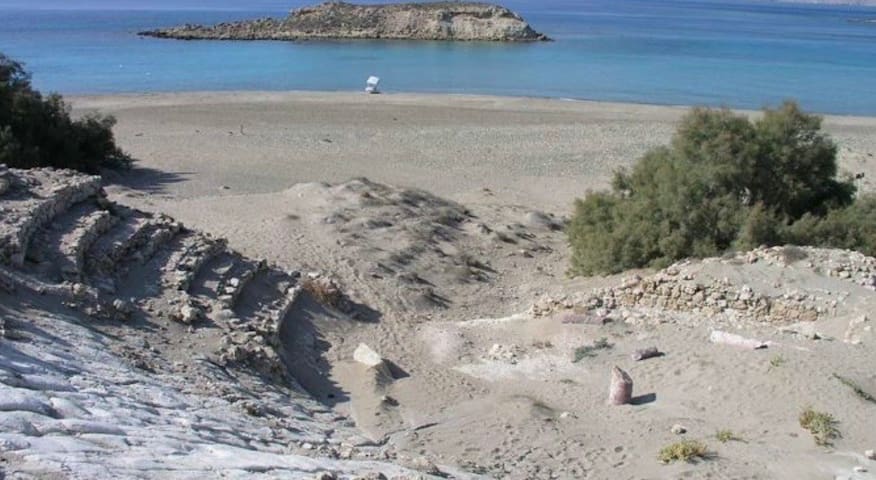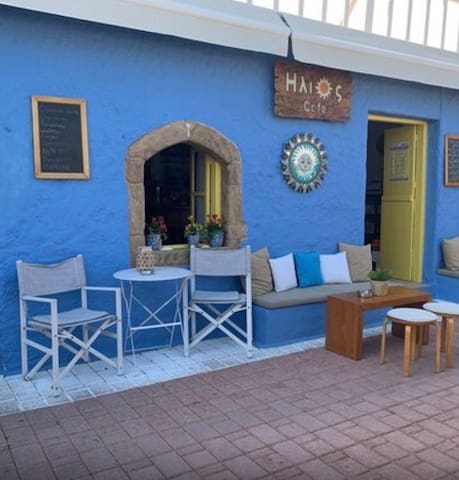Sights
Kapsa Monastery is east of Makry Gialos, on the road to Goudouras. Its full name is the Monastery of Agios Ioannis Kapsa (St John Kapsa) and it is a dependency of Toplou Monastery near Vai and Sitia.
The monastery looks as though it has been carved into the hill at the exit of Pervolakia Gorge, gazing out over the Libyan Sea and Koufonissi Island opposite.
Kapsa Monastery is open daily at 06.30-12.30 and 15.30-19.00. The rules of suitable dress for entering the church are quite strict.
kapsa monastery in crete
Kapsa Monastery celebrates its feast-day on 29 August, the Decollation of Agios Ioannis Baptist. Thousands of faithful come from various parts of Crete to attend the great festival, even coming on foot from nearby villages.
How to get to Kapsa Monastery
Kapsa Monastery is 7 km from Makry Gialos. If you are coming from Sitia (37 km), you need to turn towards Goudouras, while if you are coming from Ierapetra (32 km east), just keep straight along the road after Makry Gialos and Analipsis.
The tarmac road offers an exceptional view of the small bays nearby. You might like to stop for a swim in one of them, it’s extremely tempting!
The history of Kapsa Monastery
kapsa monasteryAccording to the most widely-accepted view, Kapsa Monastery was founded in the 15th century, though other sources indicate it may have been established much earlier in the 14th or even the 13th century.
In 1471 the Turks raided it from the sea and destroyed a large part of the monastery. The area passed through many hands and was named after one of its owners, who was called Kapsas.
The half-ruined monastery was restored 400 years later by the monk Joseph Gerontoyiannis, who made it famous throughout Crete and indeed the rest of Greece. The work of Gerontoyiannis was continued by his grandson Joseph Gerontakis and the abbots who came after him.
Kapsa Monastery was a centre of resistance to the German forces of occupation in the period 1941-1944. Greek and British resistance operatives came here to seek refuge before being taken to Egypt by British submarines. The Abbot at the time was Hilarion Syntychakis, who was forced to abandon the monastery along with the other monks in November 1943, by order of the Germans. After the war, however, they returned.
Saint Joseph Gerontoyiannis
saint joseph gerontoyiannisIn 1799 Ioannis Vitsentzos or Gerontoyiannis (“Old John”) was born in the half-ruined monastery. This was the man who was destined to restore Kapsa Monastery in 1861. In his youth Gerontoyiannis was not exactly virtuous or a good Christian. He was a brawling, stubborn, hard-hearted man who used the monastery and the nearby gorge as his hideout when the Turks were after him.
He married and had four children, three daughters and a son. One Sunday he and his wife Calliope went off to sell wood and buy wine from the neighbouring villages of Chandras and Armeni. The children were left alone and this proved fatal to one of his daughters, who was burned to death in a fire. Gerontoyiannis saw this tragic accident as divine punishment for his sinful life and because he worked that Sunday instead of going to church.
From that moment onwards his life changed completely and he became a reformed character. Gerontoyiannis devoted his life to works of charity and the worship of God. It is said that he saw visions and healed all those who came to him for help. Kapsa Monastery, where he lived, became famous throughout Crete and many pilgrims came here from afar to pray. One of the faithful was the local landowner, Chatzi Nikolaos Zafiris, who gave the land to Gerontoyiannis in 1841 to restore the monastery.
Gerontoyiannis worked hard for the restoration of the monastery, but our information on the state of Kapsa Monastery in 1841 is scanty. The only fact we know for certain are that it included the cave church of Agios Ioannis, a well with brackish water, and two half-ruined buildings which were restored and can still be seen today.
the cave at kapsa where gerontoyannis lived
the cave where Gerontoyannis lived
The work on Kapsa Monastery continued for years, while the second aisle of the monastery, devoted to the Holy Trinity, was built in 1861. The carved wooden icon screen of Kapsa Monastery was made in 1869 by Chatziminas and painted in 1874 by Antonis Alexandridis.
Gerontoyiannis himself, who had become a monk and taken the name Joseph, lived in a cave 100 yards from the monastery and continued to preach and heal until his death on 6 August 1874. Today he is honoured as Agios Iosif Gerontoyiannis (Saint Josef Gerontoyiannis ) on 7 August.
12 personas locales recomiendan
Moni Kapsa
Kapsa Monastery is east of Makry Gialos, on the road to Goudouras. Its full name is the Monastery of Agios Ioannis Kapsa (St John Kapsa) and it is a dependency of Toplou Monastery near Vai and Sitia.
The monastery looks as though it has been carved into the hill at the exit of Pervolakia Gorge, gazing out over the Libyan Sea and Koufonissi Island opposite.
Kapsa Monastery is open daily at 06.30-12.30 and 15.30-19.00. The rules of suitable dress for entering the church are quite strict.
kapsa monastery in crete
Kapsa Monastery celebrates its feast-day on 29 August, the Decollation of Agios Ioannis Baptist. Thousands of faithful come from various parts of Crete to attend the great festival, even coming on foot from nearby villages.
How to get to Kapsa Monastery
Kapsa Monastery is 7 km from Makry Gialos. If you are coming from Sitia (37 km), you need to turn towards Goudouras, while if you are coming from Ierapetra (32 km east), just keep straight along the road after Makry Gialos and Analipsis.
The tarmac road offers an exceptional view of the small bays nearby. You might like to stop for a swim in one of them, it’s extremely tempting!
The history of Kapsa Monastery
kapsa monasteryAccording to the most widely-accepted view, Kapsa Monastery was founded in the 15th century, though other sources indicate it may have been established much earlier in the 14th or even the 13th century.
In 1471 the Turks raided it from the sea and destroyed a large part of the monastery. The area passed through many hands and was named after one of its owners, who was called Kapsas.
The half-ruined monastery was restored 400 years later by the monk Joseph Gerontoyiannis, who made it famous throughout Crete and indeed the rest of Greece. The work of Gerontoyiannis was continued by his grandson Joseph Gerontakis and the abbots who came after him.
Kapsa Monastery was a centre of resistance to the German forces of occupation in the period 1941-1944. Greek and British resistance operatives came here to seek refuge before being taken to Egypt by British submarines. The Abbot at the time was Hilarion Syntychakis, who was forced to abandon the monastery along with the other monks in November 1943, by order of the Germans. After the war, however, they returned.
Saint Joseph Gerontoyiannis
saint joseph gerontoyiannisIn 1799 Ioannis Vitsentzos or Gerontoyiannis (“Old John”) was born in the half-ruined monastery. This was the man who was destined to restore Kapsa Monastery in 1861. In his youth Gerontoyiannis was not exactly virtuous or a good Christian. He was a brawling, stubborn, hard-hearted man who used the monastery and the nearby gorge as his hideout when the Turks were after him.
He married and had four children, three daughters and a son. One Sunday he and his wife Calliope went off to sell wood and buy wine from the neighbouring villages of Chandras and Armeni. The children were left alone and this proved fatal to one of his daughters, who was burned to death in a fire. Gerontoyiannis saw this tragic accident as divine punishment for his sinful life and because he worked that Sunday instead of going to church.
From that moment onwards his life changed completely and he became a reformed character. Gerontoyiannis devoted his life to works of charity and the worship of God. It is said that he saw visions and healed all those who came to him for help. Kapsa Monastery, where he lived, became famous throughout Crete and many pilgrims came here from afar to pray. One of the faithful was the local landowner, Chatzi Nikolaos Zafiris, who gave the land to Gerontoyiannis in 1841 to restore the monastery.
Gerontoyiannis worked hard for the restoration of the monastery, but our information on the state of Kapsa Monastery in 1841 is scanty. The only fact we know for certain are that it included the cave church of Agios Ioannis, a well with brackish water, and two half-ruined buildings which were restored and can still be seen today.
the cave at kapsa where gerontoyannis lived
the cave where Gerontoyannis lived
The work on Kapsa Monastery continued for years, while the second aisle of the monastery, devoted to the Holy Trinity, was built in 1861. The carved wooden icon screen of Kapsa Monastery was made in 1869 by Chatziminas and painted in 1874 by Antonis Alexandridis.
Gerontoyiannis himself, who had become a monk and taken the name Joseph, lived in a cave 100 yards from the monastery and continued to preach and heal until his death on 6 August 1874. Today he is honoured as Agios Iosif Gerontoyiannis (Saint Josef Gerontoyiannis ) on 7 August.
The palm beach of Vai (Greek: Βάι) is one of the largest attractions of the Mediterranean island of Crete.
For tourism Vai was discovered at the beginning of the 1970s by Richard White and friends[citation needed][who?] from North London, Belfast and Bavaria, at the end of that decade it was popularised by the last hippies who fled the hot-spots Matala and Preveli. At the beginning of the 1980s Vai was full of backpacker tourists from the whole world, leading to a mixture of chaotic campground and garbage dump. Vai was enclosed and declared as a protected area. The unique forest recovered, the beach became clean.
The palm beach, which belongs to the Moni Toplou, is the touristic centre of East Crete, with thousands of visitors each year. Vai lies close to Palekastro, Sitia and the Dionysades islands.
55 personas locales recomiendan
Vai
The palm beach of Vai (Greek: Βάι) is one of the largest attractions of the Mediterranean island of Crete.
For tourism Vai was discovered at the beginning of the 1970s by Richard White and friends[citation needed][who?] from North London, Belfast and Bavaria, at the end of that decade it was popularised by the last hippies who fled the hot-spots Matala and Preveli. At the beginning of the 1980s Vai was full of backpacker tourists from the whole world, leading to a mixture of chaotic campground and garbage dump. Vai was enclosed and declared as a protected area. The unique forest recovered, the beach became clean.
The palm beach, which belongs to the Moni Toplou, is the touristic centre of East Crete, with thousands of visitors each year. Vai lies close to Palekastro, Sitia and the Dionysades islands.
Chrysi or Chrisi is an uninhabited Greek island approximately 15 kilometres (9 miles) south of Crete close to Ierapetra in the South Cretan Sea.[1] Approximately 700 metres (2,300 feet) east of the island is the island of Mikronisi. Administratively these islands fall within the Ierapetra municipality in Lasithi.
It contains a small church and harbour on its northwestern coast, Ekklisia Agios Nikolaos.
107 personas locales recomiendan
Chrysi
Chrysi or Chrisi is an uninhabited Greek island approximately 15 kilometres (9 miles) south of Crete close to Ierapetra in the South Cretan Sea.[1] Approximately 700 metres (2,300 feet) east of the island is the island of Mikronisi. Administratively these islands fall within the Ierapetra municipality in Lasithi.
It contains a small church and harbour on its northwestern coast, Ekklisia Agios Nikolaos.
Pefki is a traditional village 7 km north of Μakry Gialos in southeast Crete.
Pefki is a semi-mountainous village set out on the mountainside at an altitude of 420 m, and offers a panoramic view of the green local landscape.
More precisely, the village of Pefki is built on the slope of the low Romanati range, below the peak of Afendis Estavromenos.
15 personas locales recomiendan
Pefki Gorge
Pefki is a traditional village 7 km north of Μakry Gialos in southeast Crete.
Pefki is a semi-mountainous village set out on the mountainside at an altitude of 420 m, and offers a panoramic view of the green local landscape.
More precisely, the village of Pefki is built on the slope of the low Romanati range, below the peak of Afendis Estavromenos.
The island has beautiful sandy beaches, it is mainly covered with fine sand and the scenery is not very different from an African desert. Visitors can admire the beauty of white rocks next to the blue of the sea and enjoy the tranquility of nature in turquoise waters. The landscapes alternate from the steep rocky shoreline, to the caves of yellow marl and the endless dunes. The prevailing vegetation is low, bushy, steppic and with many species, rare in the Greek and Cretan area. Characteristic species are Helianfhemmum stipulalum, the Lygeum spartum (grass of North Africa), Austragalus peregrinus (characteristic of the southern Mediterranean) and the rare Erodium classifolium, located at the northernmost point of its spread.
17 personas locales recomiendan
Koufonisi
The island has beautiful sandy beaches, it is mainly covered with fine sand and the scenery is not very different from an African desert. Visitors can admire the beauty of white rocks next to the blue of the sea and enjoy the tranquility of nature in turquoise waters. The landscapes alternate from the steep rocky shoreline, to the caves of yellow marl and the endless dunes. The prevailing vegetation is low, bushy, steppic and with many species, rare in the Greek and Cretan area. Characteristic species are Helianfhemmum stipulalum, the Lygeum spartum (grass of North Africa), Austragalus peregrinus (characteristic of the southern Mediterranean) and the rare Erodium classifolium, located at the northernmost point of its spread.
Food scene
Excellent breakfast. You must taste the omelet with fresh eggs and healthy sandwiches. Also the night is a beautifull cocktail spot.
Ηλιος Cafe
Excellent breakfast. You must taste the omelet with fresh eggs and healthy sandwiches. Also the night is a beautifull cocktail spot.
Traditional Cretan gastronomy. Please eat "nerati" with honey. You can drink raki (traditional cratan alcohol drink). Every Sunday Piperia Tavern has Fest with Cretan Music. The fest starts 8.30. Please make reservation
22 personas locales recomiendan
Piperia
402 Epar.Od. Ierapetras - SitiasTraditional Cretan gastronomy. Please eat "nerati" with honey. You can drink raki (traditional cratan alcohol drink). Every Sunday Piperia Tavern has Fest with Cretan Music. The fest starts 8.30. Please make reservation
Petra Bay
Ταβέρνα - Η Σπηλία του Δράκου "Dragon's Cave"
ΛαγκάδαΣτραβοδοξάρι Κουτσουράς
Eparchiaki Odos Koutsouras-StavrochoriouFor coffee delivery. You can take away your coffee or you can make a call and make your order for delivery.
Phone number +302843 051051
For address just say “Dioni Boutique House” or Rianas’ house
Deλογω
21 Eparchiaki Odos Ierapetras - SitiasFor coffee delivery. You can take away your coffee or you can make a call and make your order for delivery.
Phone number +302843 051051
For address just say “Dioni Boutique House” or Rianas’ house
Diaskari Taverna
LagkadaDrinks
Coukos Island
Clumps Island for morning coffee on the beach or for night drinks.






